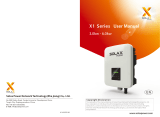
FORCE SERIES INVERTER - USER MANUAL
5
2.2 PE Connection and Leakage Current
PV System Residual Current Factors
• IneveryPVinstallation,severalelementscontributetothecurrentleakagetoprotectiveearth(PE).theseelementscanbe
divided into two main types.
• Capacitive discharge current - Discharge current is generated mainly by the parasitic capacitance of the PV modules to PE. The
moduletype,theenvironmentalconditions(rain,humidity)andeventhedistanceofthemodulesfromtheroofcaneectthe
discharge current. Other factors that may contribute to the parasitic capacitance are the inverter’s internal capacitance to PE and
external protection elements such as lighting protection.
• Duringoperation,theDCbusisconnectedtothealternatingcurrentgridviatheinverter.Thus,aportionofthealternating
voltageamplitudearrivesattheDCbus.TheuctuatingvoltageconstantlychangesthechargestateoftheparasiticPVcapacitor
(i.ecapacitancetoPE).Thisisassociatedwithadisplacementcurrent,whichisproportionaltothecapacitanceandtheapplied
voltage amplitude.
• Residualcurrent-ifthereisafault,suchasdefectiveinsulation,whereanenergizedcablecomesintocontactwithagrounded
person,anadditionalcurrentows,knownasaresidualcurrent.
Residual Current Device (RCD)
• AllEnergizerinvertersincorporateacertiedinternalRCD(ResidualCurrentDevice)toprotectagainstpossibleelectrocutionin
caseofamalfunctionofthePVarray,cablesorinverter(DC).TheRCDintheEnergizerinvertercandetectleakageontheDC
side. There are 2 trip thresholds for the RCD as required by the DIN VDE 0126-1-1 standard. A low threshold is used to protect
againstrapidchangesinleakagetypicalofdirectcontactbypeople.Ahigherthresholdisusedforslowlyrisingleakagecurrents,
tolimitthecurrentingroundingconductorsforthesafety.Thedefaultvalueforhigherspeedpersonalprotectionis30mA,and
300mAperunitforlowerspeedresafety.
Installation and Selection of an External RCD device
• AnexternalRCDisrequiredinsomecountries.TheinstallermustcheckwhichtypeofRCDisrequiredbythespeciclocalelectric
codes. Installation of an RCD must always be conducted in accordance with local codes and standards. Energizer recommends
theuseofatype-ARCD.Unlessalowervalueisrequiredbythespeciclocalelectriccodes,EnergizersuggestsanRCDvalue
between 100mA and 300mA.
• IninstallationswherethelocalelectriccoderequiresanRCDwithalowerleakageseing,thedischargecurrentmightresultin
nuisance tripping of the external RCD. The following steps are recommended to avoid nuisance tripping of the external RCD:
1. Selecting the appropriate RCD is important for correct operation of the installation. An RCD with a rating of 30mA may actually trip
at a leakage as 15mA (according to IEC 61008). High quality RCDs will typically trip at a value closer to their rating.
2.Congurethetripcurrentoftheinverter’internalRCDtoalowervaluethanthetripcurrentoftheexternalRCD.TheinternalRCD
willtripifthecurrentishigherthantheallowedcurrent,butbecausetheinternalinverterRCDautomaticallyresetswhentheresidual
currents are low it saves the manual reset.
2.3 Surge Protection Devices (SPDs) for PV Installation
WARNING!
Over-voltage protection with surge arresters should be provided when the PV power system is installed. The grid connected inverter
isnotedwithSPDsinbothPVinputsideandmainssideLightningwillcausedamageeitherfromadirectstrikeorfromsurgesdue
toanearbystrike.Inducedsurgesarethemostlikelycauseoflightningdamageinmajorityorinstallations,especiallyinruralareas
where electricity is usually provided by long overhead lines. Surges may impact on both the PV array conduction and the AC cables
leading to the building. Specialists in lightning protection should be consulted during the end use application. Using appropriate
externallightningprotection,theeectofadirectlightningstrikeintoabuildingcanbemitigatedinacontrolledway,andthe
lightning current can be discharged into the ground.
Installation of SPDs to protect the inverter against mechanical damage and excessive stress include a surge arrester in case of
abuildingwithexternallightningprotectionsystem(LPS)whenseparationdistanceiskept.ToprotecttheDCsystem,surge
suppressiondevice(SPDtype2)shouldbeedattheinverterendoftheDCcablingandatthearraylocatedbetweentheinverter
andthePVgenerator,ifthevoltageprotectionlevel(VP)ofthesurgearrestersisgreaterthan1100V,anadditionalSPDtype3is
required for surge protection for electrical devices.






















